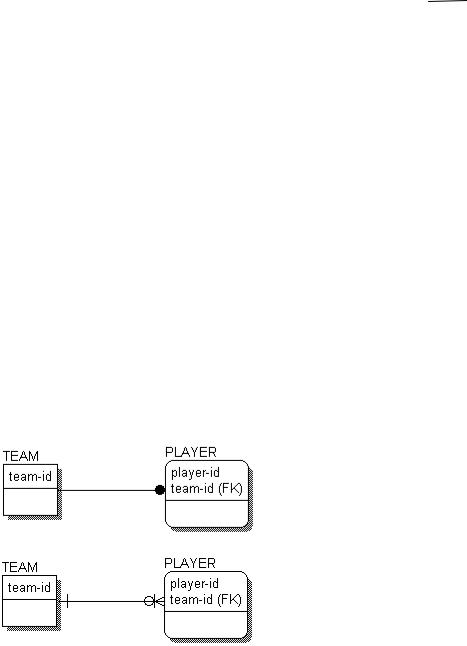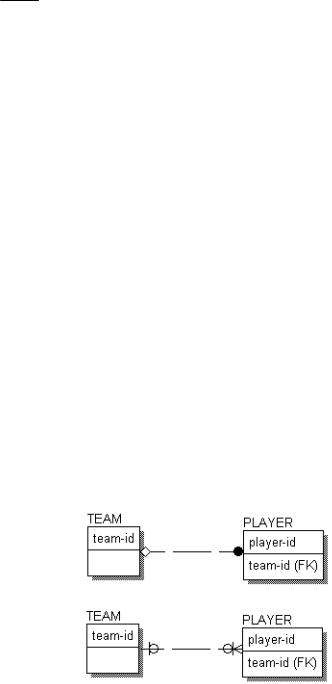
- •Contents
- •Preface
- •Intended Audience
- •About this Guide
- •Typographical Conventions
- •Related Documentation
- •What’s In This Chapter?
- •Chapter Contents
- •What is Data Modeling?
- •Data Modeling Sessions
- •Session Roles
- •Sample IDEF1X Modeling Methodology
- •Logical Models
- •The Entity Relationship Diagram
- •The Key-Based Model
- •The Fully-Attributed (FA) Model
- •Physical Models
- •The Transformation Model
- •The DBMS Model
- •Benefits of Modeling in ERwin
- •What’s In This Chapter?
- •Chapter Contents
- •The Entity-Relationship Diagram
- •Defining Entities and Attributes
- •Logical Relationships
- •Many-to-Many Relationships
- •Validating the Design of the Logical Model
- •Data Model Example
- •What’s In This Chapter?
- •Chapter Contents
- •Understanding Keys
- •Selecting a Primary Key
- •Designating Alternate Key Attributes
- •Inversion Entry Attributes
- •Relationships and Foreign Key Attributes
- •Dependent and Independent Entities
- •Identifying Relationships
- •Non-Identifying Relationships
- •Rolenames
- •What’s In This Chapter?
- •Chapter Contents
- •Naming Entities and Attributes
- •Synonyms, Homonyms and Aliases
- •Entity Definitions
- •Descriptions
- •Business Examples
- •Comments
- •Definition References and Circularity
- •Constructing a Business Glossary
- •Attribute Definitions
- •Rolenames
- •Definitions and Business Rules
- •What’s In This Chapter?
- •Chapter Contents
- •Relationship Cardinality
- •Cardinality in Non-Identifying Relationships
- •Referential Integrity
- •Reading Referential Integrity Options
- •RI, Cardinality, and Identifying Relationships
- •RI, Cardinality, and Non-Identifying Relationships
- •Additional Relationship Types
- •Many-to-Many Relationships
- •N-ary Relationships
- •Recursive Relationships
- •Subtype Relationships
- •Complete Versus Incomplete Subtype Structures
- •Inclusive and Exclusive Relationships
- •IDEF1X and IE Subtype Notation
- •When to Create a Subtype Relationship
- •Introduction
- •Chapter Contents
- •Overview of the Normal Forms
- •Functional Dependence (FD)
- •Full Functional Dependence
- •First Normal Form (1NF)
- •Second Normal Form (2NF)
- •Third Normal Form (3NF)
- •Common Design Problems
- •Repeating Data Groups
- •Multiple Use of the Same Attribute
- •Multiple Occurrences of the Same Fact
- •Conflicting Facts
- •Derived Attributes
- •Missing Information
- •Unification
- •How Much Normalization Is Enough?
- •Conclusions
- •ERwin Support for Normalization
- •First Normal Form Support
- •Second and Third Normal Form Support
- •What’s In This Chapter?
- •Chapter Contents
- •Creating a Physical Model
- •Denormalization
- •Classification of Dependent Entities
- •Glossary of Terms
- •Index
- •Documentation Comments Form

3 |
ERwin Methods Guide |
|
|
Relationships and Foreign Key Attributes
Just as a RDBMS captures relationships using shared key values, ERwin also represents relationships using shared keys. Although ERwin certainly can be used to model information that is stored in non-relational data base management systems, in its treatment of keys, ERwin is relational.
Whenever entities in a ERwin diagram are connected by a relationship, the relationship contributes a key (or set of key attributes) to the child entity. These attributes are called the foreign key. Foreign key attributes are defined as primary key attributes of a parent entity contributed to a child entity across a relationship. The contributed keys are said to migrate from parent to child. Foreign key attributes are designated in the model by an (FK) following the attribute name. Notice the (FK) next to “parent-key” in the figure below.
PLAYER Entity With Migrated Foreign Key (FK)
Dependent and Independent Entities
As you develop your model, you may discover certain entities that depend on the value of the foreign key attribute for uniqueness. For these entities, the foreign key must be a part of the primary key of the child entity (above the line) in order to uniquely define each entity.
In relational terms, a child entity that depends on the foreign key attribute for uniqueness is called a dependent entity. In the example above, PLAYER is considered a dependent entity because it depends on the TEAM entity for its identification. In IDEF1X, dependent entities are represented as roundcornered boxes.
Dependent entities are further classified as existence dependent, which means the dependent entity cannot exist unless its parent does, and identification dependent, which means that the dependent entity cannot be identified without using the key of the parent. The PLAYER entity is identification dependent, but not existence dependent, because PLAYERs can exist if they are not on a TEAM.
32 ∙ The Key-Based Model

ERwin Methods Guide |
3 |
|
|
In contrast, there are situations in which an entity is existence dependent on another entity. Consider two entities: ORDER, which the business uses to track customer orders, and LINE ITEM, which tracks individual items in an ORDER. The relationship between these two entities can be expressed as An ORDER <contains> one or more LINE ITEMS. In this case, LINE ITEM is existence dependent on ORDER, because it makes no sense in the business context to track LINE ITEMS unless there is a related ORDER.
Entities that do not depend on any other entity in the model for identification are called independent entities. In the example above, TEAM is considered an independent entity. In IE and IDEF1X, independent entities are represented as square-cornered boxes.
Identifying Relationships
In IDEF1X, the concept of dependent and independent entities is enforced by type of the relationship that connects two entities. If you want the foreign key to migrate to the key area of the child entity (and create a dependent entity as a result), you can create an identifying relationship between the parent and child entities.
Identifying relationships are indicated by a solid line connecting the entities. In IDEF1X, the line includes a dot on the end nearest to the child entity, as shown below. In IE, the line includes “crows feet” at the end of the relationship nearest to the child entity.
Identifying Relationship in IDEF1X Notation (top) and IE Notation (bottom)
Note: Standard IE notation does not include rounded corners on entities. This is an IDEF1X symbol that is included in IE notation in ERwin to ensure compatibility between methods.
The Key-Based Model ∙ 33

3 |
ERwin Methods Guide |
|
|
As you saw in the discussion of independent and dependent entities, the business rule that indicates that a relationship is identifying results from an intentional choice to identify the child entity by using the identifier of the parent entity. In our example of MOVIEs and MOVIE-COPYs, we could have chosen to identify the copy by its own unique number. Instead, we decided to use the identifier of the MOVIE and add a second part (copy-number) to tell one copy from another.
Note: As you may find, there are advantages to contributing keys to a child entity through identifying relationships in that it tends to make some physical system queries more straightforward, but there are also many disadvantages. Some advanced relational theory suggests that contribution of keys should not occur in this way. Instead, each entity should be identified not only by its own primary key, but also by a logical handle or surrogate key, never to be seen by the user of the system. There is a strong argument for this in theory and those who are interested are urged to review the work of E. F. Codd and C. J. Date in this area.
Non-Identifying Relationships
Non-identifying relationships, which are unique to the IDEF1X notation, also connect a parent entity to a child entity. Non-identifying relationship are used to show a different migration of the foreign key attribute(s) – migration to the data area of the child entity (below the line).
Non-identifying relationships are indicated by a dashed line connecting the entities. If you connect the TEAM and PLAYER entities in a non-identifying relationship, the model appears as shown below.
Non-Identifying Relationship in IDEF1X Notation (Top) and IE Notation (bottom)
34 ∙ The Key-Based Model

ERwin Methods Guide |
3 |
|
|
Because the migrated keys in a non-identifying relationship are not part of the primary key of the child, non-identifying relationships do not result in any identification dependency. In this case, PLAYER is considered an independent entity, just like TEAM.
However, the relationship can reflect existence dependency if the business rule for the relationship specifies that the foreign key cannot be NULL (“missing”). If the foreign key must exist, this implies that an instance in the child entity can only exist if an associated parent instance also exists.
Note: Identifying and non-identifying relationships are not a feature of the IE method. However, this information is included in your ERwin diagram in the form of a solid or dashed relationship line to ensure compatibility between IE and IDEF1X methods.
The Key-Based Model ∙ 35
